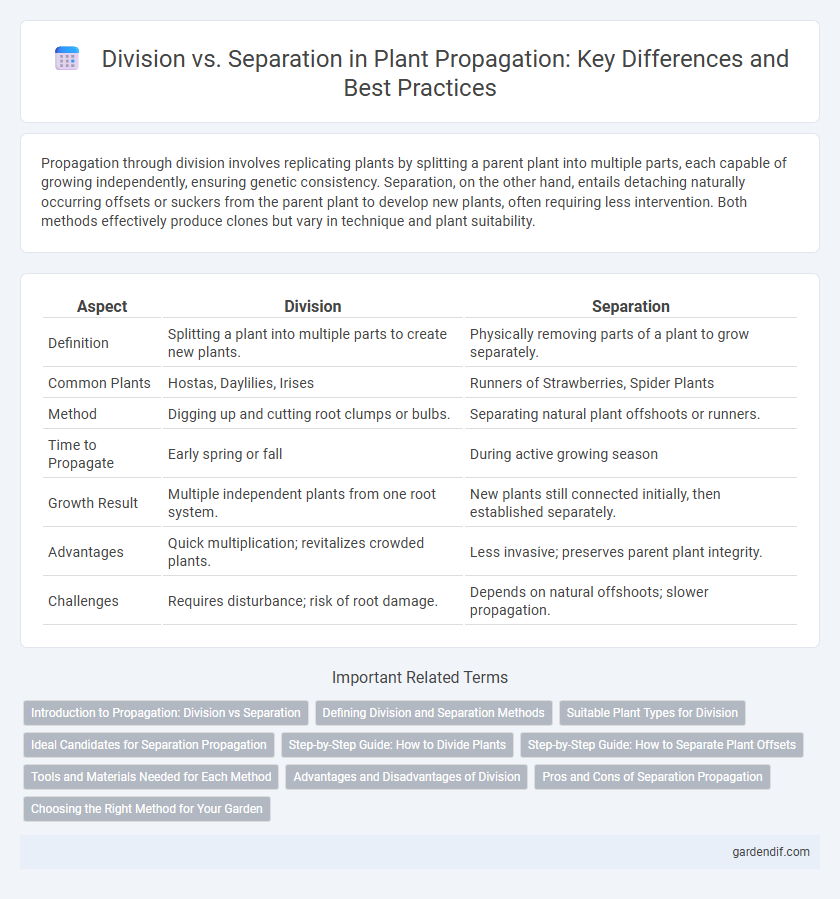
Division vs Separation Illustration
Propagation through division involves replicating plants by splitting a parent plant into multiple parts, each capable of growing independently, ensuring genetic consistency. Separation, on the other hand, entails detaching naturally occurring offsets or suckers from the parent plant to develop new plants, often requiring less intervention. Both methods effectively produce clones but vary in technique and plant suitability.
Table of Comparison
| Aspect | Division | Separation |
|---|---|---|
| Definition | Splitting a plant into multiple parts to create new plants. | Physically removing parts of a plant to grow separately. |
| Common Plants | Hostas, Daylilies, Irises | Runners of Strawberries, Spider Plants |
| Method | Digging up and cutting root clumps or bulbs. | Separating natural plant offshoots or runners. |
| Time to Propagate | Early spring or fall | During active growing season |
| Growth Result | Multiple independent plants from one root system. | New plants still connected initially, then established separately. |
| Advantages | Quick multiplication; revitalizes crowded plants. | Less invasive; preserves parent plant integrity. |
| Challenges | Requires disturbance; risk of root damage. | Depends on natural offshoots; slower propagation. |
Introduction to Propagation: Division vs Separation
Division in plant propagation involves splitting a mature plant into multiple segments, each capable of growing independently, typically preserving the parent plant's characteristics. Separation refers to detaching naturally formed offshoots or runners from the main plant to establish new plants, ensuring genetic consistency. Both techniques promote efficient propagation of perennials, enhancing plant multiplication without seeds.
Defining Division and Separation Methods
Division involves physically cutting or breaking a parent plant into sections, each capable of growing independently, commonly used for herbaceous perennials and grasses. Separation, on the other hand, refers to gently pulling apart naturally forming plant structures like bulbs, tubers, or offsets to create new plants. Both methods rely on the plant's ability to regenerate roots and shoots from the divided or separated parts, ensuring successful propagation.
Suitable Plant Types for Division
Division is suitable for herbaceous perennials with clumping growth habits, such as daylilies, hostas, and irises, which naturally form multiple crowns or shoots. These plants tolerate root disturbance and regenerate quickly after being split into sections. Separation is ideal for plants with natural offsets or suckers like strawberries, bromeliads, and some succulents, where individual plantlets can be easily detached and rooted independently.
Ideal Candidates for Separation Propagation
Ideal candidates for separation propagation include plants with naturally segmented structures, such as hostas, lilies, and daylilies, which exhibit robust root systems and multiple crowns. Separation is particularly effective for mature perennials that can be divided without significant stress, ensuring rapid establishment and growth. Plants with tuberous roots or clumping growth habits also respond well to separation, promoting healthy propagation and genetic consistency.
Step-by-Step Guide: How to Divide Plants
Divide plants by carefully digging up the root clump and gently teasing apart roots into sections, ensuring each division has healthy roots and shoots. Use a clean, sharp knife or garden shears to cut through tough roots when necessary, maintaining minimal damage to plant tissues. Replant divisions promptly in well-prepared soil, water thoroughly, and provide shade to reduce transplant shock and encourage rapid establishment.
Step-by-Step Guide: How to Separate Plant Offsets
To separate plant offsets effectively, first carefully loosen the soil around the base of the parent plant to expose the offset roots without causing damage. Gently detach the offset by cutting or pulling it away, ensuring it has a healthy root system attached. Finally, replant the offset in a well-draining pot or garden bed, water thoroughly, and maintain optimal conditions for establishment and growth.
Tools and Materials Needed for Each Method
Division requires a sharp spade or garden fork to carefully lift and separate root clumps, along with clean pruning shears to trim damaged roots. Separation involves using hands or a knife to gently pull apart or cut sections of the plant, often needing pots and fresh potting soil for transplanting. Both methods benefit from sterilized tools to prevent disease transmission and promote healthy regrowth.
Advantages and Disadvantages of Division
Division in plant propagation allows rapid multiplication of mature plants maintaining genetic uniformity and established traits, which is advantageous for consistent crop quality. However, division can cause root damage during the process, leading to slower establishment and increased susceptibility to diseases. Compared to separation, division requires careful handling and ideal environmental conditions to ensure successful regrowth and minimize plant stress.
Pros and Cons of Separation Propagation
Separation propagation allows for maintaining the genetic traits of the parent plant by detaching naturally formed offshoots or runners, ensuring stable growth and uniformity in the new plants. This technique reduces stress compared to division since it involves less root disturbance, promoting faster establishment and recovery. However, separation may limit the number of new plants produced and often requires mature plants with readily available offshoots, constraining scalability.
Choosing the Right Method for Your Garden
Division is ideal for perennials with dense root systems, promoting vigorous growth and rejuvenation by splitting established clumps, while separation suits plants that naturally form offsets or pups, allowing easier propagation without root disturbance. Selecting the right method depends on the plant species, root structure, and timing to ensure healthy transplants and sustained garden vitality. Understanding these factors helps gardeners optimize propagation success and maintain a thriving landscape.
Division vs Separation Infographic

 gardendif.com
gardendif.com